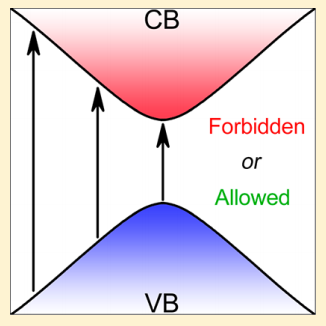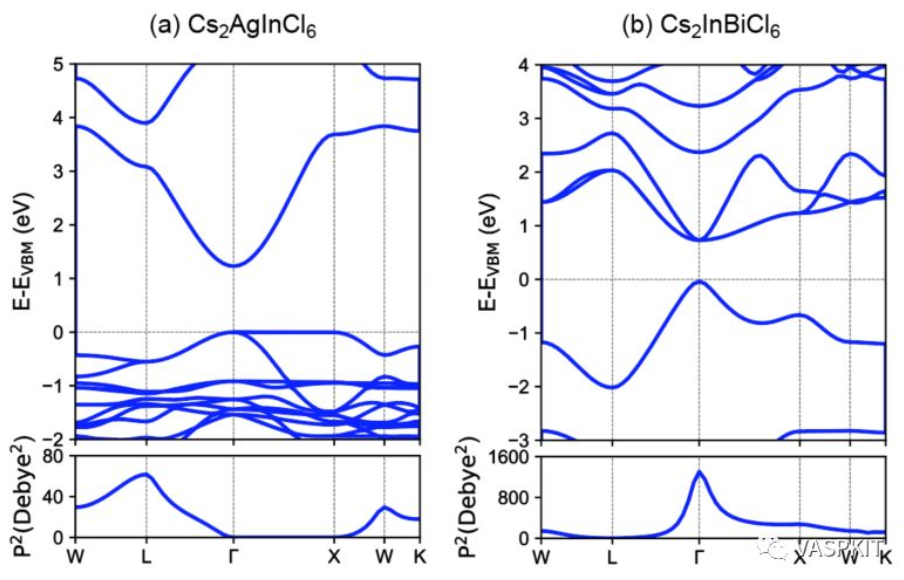本文章为原创,版权归作者王伟、刘锦程所有,文章转载请先取得作者的同意,非常欢迎转发文章链接!严禁以任何方式挪用本文内容,用于以盈利为目的各种活动。
一句话提要:跃迁电偶极矩(跃迁偶极矩,transition dipole moment)计算是激发态计算的一项重要内容,即将发布的VASPKIT v1.00版本实现了直接提取分析WAVECAR中的平面波展开系数,得到跃迁偶极矩的功能。
相关内容:
一句话提要:
跃迁电偶极矩(跃迁偶极矩,transition dipole moment)计算是激发态计算的一项重要内容,即将发布的VASPKIT v1.00版本实现了直接提取分析WAVECAR中的平面波展开系数,得到跃迁偶极矩的功能。

从材料的能带结构可以直接拿到带隙,VBM,CBM等信息,但是并不是说有合适带隙的材料就有好的光吸收系数。电子在基态和激发态之间的跃迁是否是对称性允许的,也是关键因素。在某个特定的K点,假设基态电子波函数为|i>,末态为|j>,则两个态之间的跃迁电偶极矩为<i|-r |j>。r 是坐标矢量,负号是因为电子带负电荷。有了跃迁偶极矩,可以进一步对其平方计算振子强度和荧光寿命等信息。
实例分析(双钙钛矿)
比如Cs2AgInCl6 这种双钙钛矿材料。虽然展现出较独特的白光发光特性,但其价带顶和导带底具有相同的宇称,存在跃迁禁阻;同时其中的电子和空穴的波函数分布差异极大,导致重叠面积小,降低辐射复合概率;两个因素导致其荧光产率极低(<0.1%),不具备应用价值。
通过替换掺杂,可以破坏该材料在直接带隙位置的对称性禁阻(parity-forbidden transition),从而大大提高其光吸收效率。例如,下述两篇文章都用到该思路,并且计算了其参杂以后的跃迁电偶极矩变化。
文献案例JPCL,跃迁偶极矩计算
第一篇文章(J. Phys. Chem. Lett. 2017, 8, 2999−3007)用Bi替换掉Ag,本来Cs2AgInCl6 在Gamma点是(Gamma3态到Gamma1态)禁阻跃迁,但是把Ag换成Bi,在直接带隙位置变成了(Gamma1态到Gamma4态)。进一步计算跃迁电偶极矩,发现原本在Gamma点为0,Bi替换以后变成了最大值。


对比用VASPKIT(v1.00)计算得到的结果,VB -> CB的跃迁偶极矩的平方和文献结果完全一样,只是单位不同。

文献案例Nature,跃迁偶极矩计算
第二篇(Nature 563, 541–545 (2018)),采取了用Na部分掺杂Ag的思路,从自限域激子的角度分析,其本质还是改变了原本的反演对称性(inversion symmetry),作者在不同掺杂比例下计算了跃迁偶极矩,发现40%的参杂比例达到最大值。


其中对称性可以通过quantum-espresso软件计算能带结构得到,Transition Dipole Moment在即将发布的最新版本的VASPKIT v1.00中可以很方便的获取。具体见下面例子分析:
VASPKIT v1.00 计算跃迁偶极矩
The transition dipole moment (TDM) or transition moment, usually denoted for a transition between an initial state a and a final state b, is the electric dipole moment associated with the transition between the two states. In general the TDM is a complex vector quantity that includes the phase factors associated with the two states. Its direction gives the polarization of the transition, which determines how the system will interact with an electromagnetic wave of a given polarization, while the square of the magnitude gives the strength of the interaction due to the distribution of charge within the system. The SI unit of the transition dipole moment is the Coulomb-meter (Cm); a more conveniently sized unit is the Debye (D).
For a single, nonrelativistic particle of mass m, in zero magnetic field, the TDM can alternatively be written in terms of the momentum operator, using the relationship,

where $\psi_{a}$ and $\psi_{b}$ are energy eigenstates with energy $E_{a}$ and $E_{b}$. $\text{C}_{a}$, $\text{C}_{b}$ and $\text{G}$ are plane-wave coefficients and reciprocal space vector with the same k vector, respectively, summed over the the number of plane-waves. The transition probabilities between the valence and the conduction band are revealed by the calculated sum of the squares of TDM (in unit of Debey$).
We task cubic CsPbI$_3$ perovskite phase as an example and present the PBE calculated band structures and corresponding TDM in figure below. This system has 44 valence electrons in all. Next we calcualte the squares of transition dipole moment from the highest valence band (band index 22) to the lowest conduction band (band index 23). It is found the results are well agreement with the previous finding (see Ref. J. Phys. Chem. Lett. 2017, 8, 2999−3007).

The calculating process is very similar with the band structure calcuation except for setting LWAVE= .TRUE. in the INCAR file. More details on these calculations are given in VASPKIT/examples/tdm.
1 | ------------>> |
If one want to calculate the square of TDM between two state at single k-point. Just run VASPKIT with task 712, for example,
1 | 71 |
Cleary, the calculate total-square of TDM at $\text{X}$ point for cubic CsPbI$_3$ is 201.62 Debey$$^2$$.
转载请注明来源,欢迎对文章中的引用来源进行考证,欢迎指出任何有错误或不够清晰的表达。